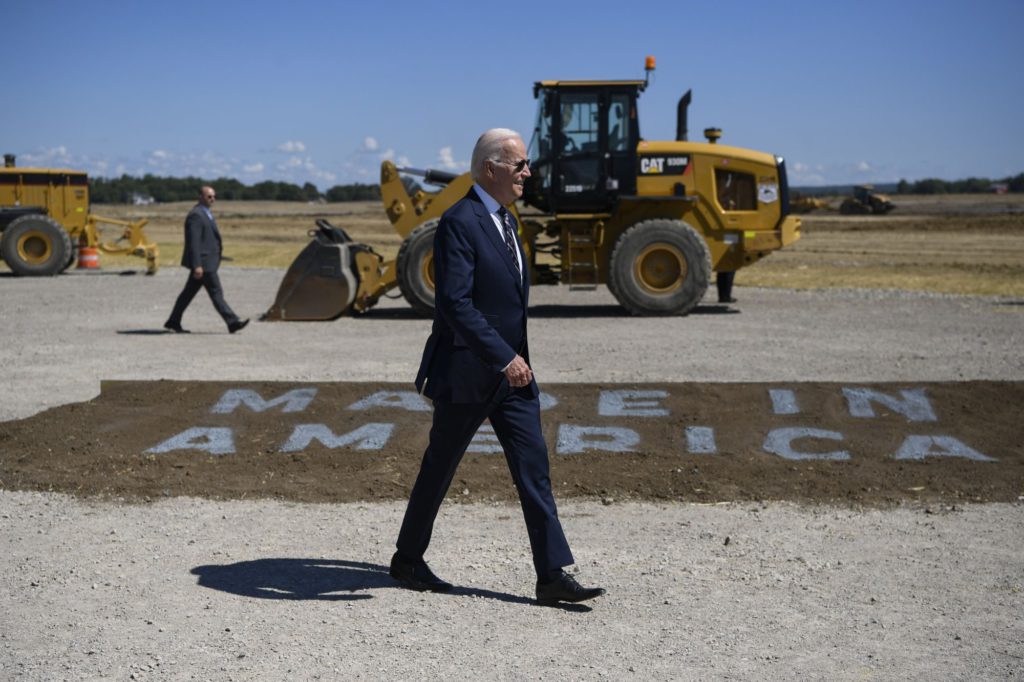(Bloomberg) — President Joe Biden’s bid to use a spate of positive economic news to turn Democrats’ biggest political liability into an election-year selling point suffered a setback with another worse-than-expected inflation report.
(Bloomberg) — President Joe Biden’s bid to use a spate of positive economic news to turn Democrats’ biggest political liability into an election-year selling point suffered a setback with another worse-than-expected inflation report.
Falling gas prices and two major legislative victories have boosted Democrats’ once improbable bid to retain their House and Senate majorities in the November midterms. So had early signals that red-hot inflation may be easing.
But Tuesday’s price growth report will dampen Democrats’ hopes that the worst may be behind them.
Headline consumer prices increased in August by 0.1%, hotter than a forecast decline of the same figure. Core inflation, a measure that strips out volatile fuel and food costs and is closely watched by the Federal Reserve, rose by 0.6%, double the forecast. Year-over-year inflation dropped for the second month, to 8.3%, but also exceeded the forecast of 8.1%.
Biden — who argues that he and his fellow Democrats have helped steer the economy back to firmer footing — is likely to try to put a positive spin on those numbers during a White House ceremony Tuesday afternoon touting a sweeping new climate, energy and health care law dubbed the “Inflation Reduction Act.”
“It will take more time and resolve to bring inflation down, which is why we passed the Inflation Reduction Act to lower the cost of health care, prescription drugs and energy,” Biden said in a statement Tuesday following the release of the latest data.
“My economic plan is showing that, as we bring prices down, we are creating good-paying jobs and bringing manufacturing back to America,” he added.
Tuesday’s event will include Cabinet secretaries and members of Congress, as well as union workers, and climate and health-care activists, according to a White House official. Biden will also emphasize that Republicans unanimously opposed the act in Congress, the official added.
Democrats have made some headway in eroding the advantage that inflation has afforded Republicans in the midterms, said Brian Stryker, a partner at Democratic polling firm Impact Research, which aided Biden’s 2020 presidential campaign and consults with gubernatorial and congressional candidates.
Yet also threatening to upend Biden’s strategy is the possibility of a rail strike that could snarl supply chains, disrupt agricultural deliveries and cost the US economy more than $2 billion a day. The Biden administration is pressuring labor unions and freight-rail operators to agree on a new contract before a Friday deadline.
Biden on Monday issued an executive order laying out priorities for the law’s execution, including reducing greenhouse gas emissions, building US clean energy capacity and creating jobs. The order also establishes a White House office on clean energy innovation and implementation.
The White House’s effort to shift the narrative included Biden’s visit Friday to a construction site in Ohio, where Intel Corp. is building a new plant to make computer chips. The trip gave the president an opportunity to highlight legislation signed into law last month aimed at boosting domestic semiconductor manufacturing.
“Since I took office, our economy has created nearly 10 million new jobs, more than 668,000 manufacturing jobs — proof of point that ‘Made in Ohio’ and ‘Made in America’ is no longer just a slogan,” Biden said at the event. “It’s a reality today. And it’s just beginning.”
The president also has pivoted away somewhat from the economy in recent weeks to highlight the threat he contends Republicans pose to democracy, most notably during a Sept. 1 prime-time speech in which he said his predecessor, Donald Trump, and Republicans who back him “represent an extremism that threatens the very foundation of our republic.”
Read more: Biden Demonizes GOP in Midterm Pivot From Uncertain Economy
Republicans, for their part, plan to keep the focus on the still-high cost of groceries, housing and other day-to-day items, even as Democrats try to use their recent accomplishments to transform the state of the economy into less of a political liability.
Democrats should aim for a repeat of 2012, when President Barack Obama was able to persuade enough voters to overlook an economic drawback — then, high unemployment — and grant him a second term, Stryker said.
“Voters thought Obama was trying and that some of those efforts would bear fruit,” he said. “That is where Democrats need to get voters.”
Biden’s overall approval rating increased six percentage points to 44% in late August, according to Gallup — his highest level in a year. The president still earns especially low marks for his handling of the economy, but the proportion of Americans who cited inflation as their top concern headed into the midterms dropped from 37% to 30% in a Sept. 8 NPR/PBS NewsHour/Marist poll.
Biden’s recent legislative victories “are meaningful both substantively and politically and have marginally improved his approval ratings and attitudes about the direction of the country,” Doug Sosnik, former White House political director under President Bill Clinton, wrote in a recent memo.
“Historical political gravity is on the Republicans’ side, but the Democrats head into the fall election with a stronger counter-narrative than they had in the spring,” Sosnik wrote.
(Adds Biden comment in fourth paragraph)
More stories like this are available on bloomberg.com
©2022 Bloomberg L.P.











